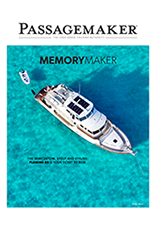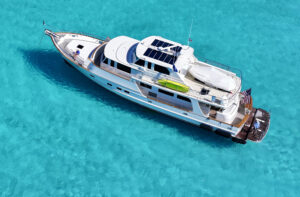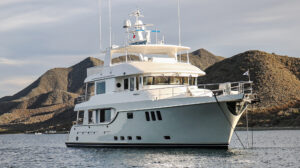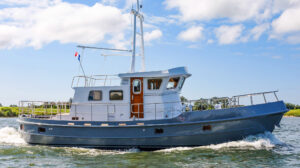I was tasked with pulling one of the historical treasures of the Northwest off the shore near Lower Port Hadlock, Washington. Lotus had been assaulted by gusty winds and broken anchorage, and had been shoved high onto the shore by 4-foot waves prior to sunrise on February 22. The alarm went out when the first rays of daylight reflected off the white superstructure, revealing her outline against the dark green shoreline. At 100 tons, Lotus was the largest motor vessel launched in 1909 from the Pacific Northwest. She was broad and beamy—her entire 92-foot length. Now, Lotus sat crippled on hard rock, burdened by her ever-increasing dead weight due to the falling tide.
Capt. Roger Slade of Vessel Assist called me with a “heads up,” that my vessel Cascade might be needed to pull her off. Cascade is 50 feet with a 16-foot beam, and has 810hp from two Cummins diesels. By telescope from my house in Port Townsend four miles north, I could see the Lotus plainly, listing seaward, an angry sea spiking up her exposed side. Usually by the time Vessel Assist calls me, it’s already a challenge: water too rough, boat too big, lying on the bottom, or on its way there. This time was no exception.
I drove out to Port Hadlock to meet Roger, and we went down the beach to where Lotus was hard over to seaward because of her keel. A ladder was already set up on the high shoreward side which was dry. A foot of water lapped against the hull on the low side. Eric Olsen, Lotus’ engineer, greeted us. Now at 1030 hours, the higher of the two daily low tides was at 3.9 feet. We clambered up the ladder, secured ourselves on the slanted forepeak deck, and used a line to slide steeply to the other side. Peering inside, we saw that everything loose in the cabin had crashed to the low side: a stove upside down; tools and table legs sticking up out of the piles of family china and other jumbled wreckage of her storied cruising history. We settled down in the stern to talk with Eric and were joined by Brion Toss, husband of owner Christian Gruye. I was impressed at his calmness, as he analyzed the staccato of information being tossed around in our somewhat desperate predicament.
“Do you think we should try this afternoon? I’m asked.”
“No, look,” I answered as I pointed down at the water level 10 feet below, “we’ll only have about 3 and a half feet more water than that. We’ll have to plan to pull at the 5:27 a.m. high tide. I’m worried we won’t have enough water even then to re-float and we’ll have to be careful not to pull her apart. The owner or master must determine at what point we are pulling too much and have to abandon the effort.”
We discussed some ways to reinforce the proposed tow points. The time was 11 a.m. and we agreed to meet at Lotus at the lowest low tide at 10:30 that night.
At that point, I was not yet contracted to take on the responsibility of Lotus. I doubted that high tide would put enough water under her to help her re-float on her own. Our yanking would stress the tow points on her, and could cause her to break up. If that happened, she would most certainly be damaged and more so as she was raked over the rocks with so much dead weight. In addition, there remained the question of whether I would have enough bollard pull to make up the difference for the lack of water. I could use long sausage-like lift bags under her, although that would incur more expense as the abrasion of moving a vessel over the beach wears out the lift bags. But if we had no other choice and the owner was willing, we could try them. In any event my liability and embarrassment was bound to either an abandoned or a sunken Lotus, both with nasty consequences.
My biggest fear was that Lotus would not float once off, if she had been damaged already underneath or dragged over the rocks. One well-placed rock under a plank butt could yank a strip open and unless the flooding could be controlled quickly, nothing would stop Lotus from going down, thus leading into the liabilities of a navigation hazard and oil spillage—though they reported only 20 gallons aboard. But this is what salvage companies do; we have proper insurance and use damage control mats for hull breaches, divers to plug fuel vents, straps, lift bags, and huge pumps. The Port of Port Townsend would place their spill response trailer nearby to contain Lotus in case the worst happened. This also raises the dilemma of cost—if all goes well there isn’t much of an increase, but cost will increase exponentially the more trouble we hit. Lotus is a local community’s prized attraction, but without insurance. A salvage operator is your friend in the moments of success, but not popular in the moment of the bill. I have to live here and face that consequence too. But to walk away and leave them without hope was not an option.
My son and crewman, Bernt, came aboard Cascade at 2100. I drove to Port Hadlock to confer again at the low 2230 tide. The beach was bright with well-placed lighting. At least 20 people were pitching in, running out pumps, repairing some visible damage to the hull, and placing plywood over the low seaward windows. This low tide of 1.9 feet exposed Lotus completely. Two outcroppings of rocks that would be in the way of a pull off were taken care of with a sledge hammer. It was encouraging to see this team effort, with enough crew that in the event of a damaged hull, flooding could possibly be overcome.
I met Christian Gruye, the owner, in the fracas of the effort to secure all potential water entries against the race of tide. “Would you like some coffee?” she said with a smile.
“No thanks,” I replied, “but I do need a few minutes to go over some things without distractions. But you take your time; you have a tide to beat.”
Watching her direct volunteers around her beloved Lotus, I felt sympathy as a boat owner myself. Soon we were able to go over the written contract and salvage plan I had prepared. Simply put, the contract acknowledged the three parties involved and that damage to Lotus was a certainty. Christian, as the owner, was responsible or could delegate responsibility to Brion, the master in charge of the vessel, for the decision to halt the pull (or to abandon the pull altogether if necessary) if we developed unbearable strain on Lotus’ structure. We discussed what depth we should settle Lotus if she did not float. The plan spelled out that once off, we might need to bring her out further to take advantage of a future high tide to float her, but not so far out that we could not work at low tide. The second party named in the contract was Roger’s Vessel Assist to provide assistance directly with Lotus and provide me, the third party, with logistics for getting my towline aboard Lotus, as the Cascade would be stationed off in deeper water.
The agreement also stated that a safety meeting would be held aboard Lotus with everyone assigned stations away from pulling stress points. “You can always replace a plank, you can’t replace your arm—or worse,” I explained. We verified how many would be aboard and required everyone to wear life jackets.
I surprised myself with some fitful sleep aboard Cascade between midnight and 3 in the morning. We set over to Port Hadlock and anchored 100 yards off Lotus. At 0430, Negotiator took our Plasma towline ashore, a synthetic fiber line only 9/16 inches in diameter and able to take 38,000 lb., doesn’t stretch, and is very slippery. The plan was to attach to Lotus’ stern tow post, which Brion had reinforced with backing to other cleats. The stern was to seaward and in slightly deeper water. We tightened the line and put Cascade in gear, gradually increasing the throttle. Next, we ran higher rpm with a static pull using the wheels (propellers). We tried even more rpm, but this created a cavitation and the pull was lost.
We slipped in neutral and relaxed the line. Then back in gear, just the idle at first, giving that bit of surge, using Cascade’s 60,000 lb. weight that was added to the pull. I radioed in and asked how that last surge on the line had been on the structure. It was fine.
Cascade gave another surge, this time with even more rpm. Our movement through the water eliminated the cavitation, and the line went taut. Cascade stopped.
It was 0525, two minutes before high tide and we still had not made any progress. I radioed in to Gabriel: “Let’s try in unison. On three.”
This wasn’t my original plan; Gabriel’s towline was at the bow and we had planned to use it to bring Lotus around once off. In this unison pull Lotus wouldn’t pivot out by her stern, but I wanted to see how “lively” she was (to see how well she might float). We tried. Nothing. Then I asked Gabriel to try alone from the bow. Lotus replied, “No movement.”
“Lotus, move my towline from the stern to the bow windlass as fast as you can. Gabriel, we are both going to pull in unison on the bow,” I said. I slacked the towline limp. It was high tide: 0527 hours. I quietly mumbled to my son Bernt, hoping they would move it quickly because we were out of time.
And that’s just what they did; we were snug again and ready in less than a minute.
We went on three. “Stop, stop, stop!” the radio shouted from Lotus. I learned later that the windlass structure had begun to bend under strain, but Brion had quickly decided to continue anyway. “Yes, tell them to go ahead again,” he said to Roger’s crewman, who relayed to me on the hand radio.
Again and again we tried, each time a bit harder. I could see Gabriel smoking and rolling under the strain. The tide was falling! Everyone knew it. Stress sweat ran down my back.
Suddenly, an explosion of steam engulfed us. The towline slipped several yards of wraps around the bit, boiling off the sea water by the heat of friction.
“Slippery stuff isn’t it?” I said.
“Yeah,” Bernt replied, with his eyebrow raised, rewrapping the warm line onto the tow bit.
“I don’t think we’re going to get her off.” My eyes focused on Lotus.
“Yeah, maybe not.”
“OK, Gabriel on three. One,” (in neutral, Cascade moved towards shore), “two,” (engaged power, throttle up), “three!” (Cascade surged ahead).
I felt it move. Lotus confirmed the movement. We continued pulling and off she came. “Ah, now that’s what I’m talking about, yes!” I said to the beach. It was 0531.
After the thrill and relief of seeing her come off the beach, the rest was anticlimactic.











